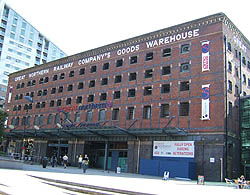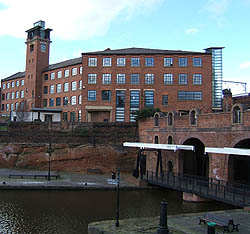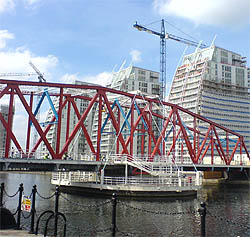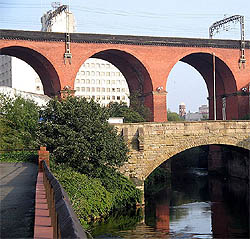Industrial heritage in the Manchester region
Manchester, the original “shock city” of industrial revolution, owes its size, shape and status to its manufacturing and trading history. By 1800, it was emerging as the focal point for a network of towns, stretching across much of Lancashire and into the north of Cheshire, which would dominate the production of cotton goods nationally, and then internationally; beyond the story of ‘Cottonopolis’, however, there were wider patterns at work: chemical production, precision engineering, and above all, freight. Over the past 250 years, the urban environment was made by these industries, and frequently remade by their collapse; in recent years, it has been remade again by new initiatives for reconstruction and renewal. All combine to make Manchester and its surroundings one of the most intense sites for industrial archaeology and exploration in the world.
 Great Northern
Great NorthernIn the city centre, Manchester’s manufacturing and merchant heritage may not be obvious, but its traces are all around you. Many ornate buildings, now converted to living apartments, were built as “warehouses” – often, in fact, opulent showrooms – for the textile trade. The Royal Exchange Theatre and Corn Exchange Shopping Centre housed the region’s main trading floors for cotton and corn, respectively. The massive brick rectangle of the Great Northern leisure complex was the docking and transhipment centre which tied the city’s road, rail and canal networks together in the late nineteenth century. The striking water feature beside the 1996 Bridgewater Hall was developed from an underground freight canal of the 1830s. And the Radisson Edwardian Hotel retains the frontage of the Free Trade Hall, the icon of manufacturing-minded Victorian Liberalism – and the site of the Peterloo Massacre of 1819.
More direct visual evidence of the mills and manufactories that made Manchester is to be found a little further from the city centre. Ancoats, in the northeast of the city, is often claimed as the world’s first industrial suburb, planned from the 1790s on a grid layout with housing for the workers of a series of large textile mills; the area was also significant in chemicals, glass production, and printing. The Northern industrial factory of visual cliché (looming rectangles, serried windows, high chimneys) was born here – and in some senses survives: many of the exteriors of the Murrays’ Mills complex, which grew along the bank of the Rochdale Canal from 1797, have been carefully restored. The recent and extensive redevelopment of the area includes a number of nods to this past – such as the Ancoats Peeps, brass portholes dotted around the landscape, allowing visitors to view hidden industrial structures and artefacts.
Less well publicised, but equally redolent sites of manufacture lie all around the city and the satellite mill-towns beyond it: some derelict, some redeveloped, a few (contrary to myth) still manufacturing things. Around Chester Street between the city centre and the University, for instance, lies the Macintosh Mills complex, historically the nucleus of Manchester’s rubber industry. As the centre of England’s textile trade, Manchester was in fact far more diversified than the smaller textile towns, which it provided with services in finance, freight, engineering, and specialised forms of production. Rubberised fabric was one such: Charles Macintosh, a Glasgow chemist, founded here in 1825 the business which gave its name to the Mackintosh waterproof coat.
 Castlefield: the canalside and reconstructed Grocers' Warehouse
Castlefield: the canalside and reconstructed Grocers' Warehouse One of the world’s most important sites for the history of transport, and perhaps the most interesting built environment in Manchester, is the Castlefield Basin. On the western side of the city, Castlefield became in 1761 the terminus of the Bridgewater Canal: the first long-distance artificial waterway, providing a reliable supply of cheap coal which was a crucial influence on Manchester’s industrial direction, and eventually a gateway to the sea. It was joined, in the 1800s, by the Rochdale canal, which crosses the city from Ancoats; and in 1830, by the Liverpool and Manchester Railway – the first passenger rail route anywhere in the world.
Unlike its Liverpool counterpart, the original Manchester station building survives, and has been incorporated into the Museum of Science and Industry. Later additions to the network saw four large viaducts ploughed through the area, radically altering the appearance of what had been, in Roman times, the site of the defensive position which gave Manchester its name. In the 1980s, the astonishingly rich history of Castlefield was acknowledged by the creation of an Urban Heritage Park, with re-creations of the Roman fort and early warehouses.
The challenge which Castlefield was engineered to answer – how can a manufacturing centre dominate international shipping markets from an inland location? – had its logical conclusion with the opening of the Manchester Ship Canal in 1894. Ocean-going ships could now navigate the 58 kilometres to the newly opened Port of Manchester docks, five kilometres west of the city centre and located mostly in neighbouring Salford and Trafford. Alongside the Port grew Trafford Park, a complex of manufacturing and distribution facilities which created the international template of the “industrial estate.” Though its key industry was electrical engineering, Trafford Park was also notably a home for familiar food and drink producers such as Kellogg’s, Hovis, Brook Bond and Guinness.
 Salford Quays during the construction of the NV Buildings apartments
Salford Quays during the construction of the NV Buildings apartments Much of Trafford Park is still operational; the Port of Manchester, however, closed in the 1980s, a victim of containerisation and growing ship sizes. Ultimately, once again, it was selected as a target for redevelopment: under the new name of Salford Quays, postmodern high-rise living quarters have risen around the huge docking areas; the area has acquired museum, gallery and retail facilities and, with the creation of Media City UK, a contended vision of a new form of industrial success.
Transport heritage has particular popular appeal, and there are several interesting sites locally. The Greater Manchester Museum of Transport at Cheetham Hill features a large collection of buses; Heaton Park Tramway is based on a recovered section of the tracks which, before the coming of the motor bus, used to crisscross every town and city in industrial England. Further north, the East Lancashire Railway is one of Britain’s many “heritage railways”, leisure attractions running on sections of the vast national rail network abandoned for regular passenger purposes, with vintage diesel and steam engines and authentic period rolling-stock.
The Lancashire mill-towns clustered around Manchester have their own heritage stories to tell. Among the more prominent sites are the Bolton Steam Museum, with its collection of working engines rescued from local sites; Astley Green Colliery Museum, a former working coal extraction site alongside the Bridgewater Canal; and the Portland Basin Museum at Ashton-under-Lyne, at an important junction in the canal network, with displays on local industrial life.
Cheshire, to the south, is often thought of as less industrial territory, being dominated by farmland; but towns here made themselves into “little Manchesters” too – and some rural manufacturers made their mills into towns. Quarry Bank at Styal is not to be missed: one of the best-preserved examples not only of a classic textile mill, with a functioning water-wheel and regular demonstrations, but also of the workers’ housing built for the site.
 Part of the Viaduct
Part of the Viaduct Stockport, close enough to the mothership to be formally part of Greater Manchester today, achieved a local dominance of one particular branch of the textile industry which is commemorated in the town’s Hat Works museum; the town’s most striking industrial legacy, however, is its enormous railway viaduct, one of the largest brick structures in Europe.
Some towns further to the south focused not on cotton but on silk: Macclesfield was the centre of this trade, and has not one, but three silk heritage sites open to the public. Other sites include the Anson Engine Museum near Poynton, with its colliery engines; Bollington Discovery Centre tells the history of the town in general, while acknowledging its own status as a converted mill building. Little Moreton Hall near Congleton might easily be overlooked by the industrial historian, being a fifteenth-century rural manor house: the building has been preserved, however, in such a way as to provide fascinating glimpses of the building techniques behind its development.
Southern central Cheshire was salt-mining territory: the Weaver Hall Museum at Northwich covers the industry, and also tells the story of its own building, a former “workhouse” of a kind used across Britain as a form of punitive poor relief. The flat plains of Cheshire, moreover, were a gift to the development of the industrial freight network.The Anderton Boat Lift, a self-explanatory oddity of the canal era, survives in working order with its control systems on public display. In the railway age, however, all roads led to Crewe, whose role as the first and definitive railway junction is described in its own Heritage Centre.